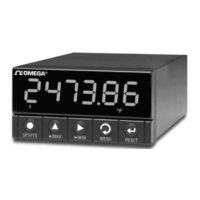8-10
8. Command and Response Structure
8.3.3 NO ECHO MODE continued
Where “nn” is the meter’s address in HEX format and is omitted from the response
format if the communication is in the point-to-point mode. “ccc” is the three (3)
character command prefix letter and it’s suffix number. “d” is one ASCII character.
“[hh]” is the optional checksum “CR” is carriage return “[<LF>]” is optional line feed.
“[Sa[b]]” is the optional alarm status character followed by the optional peak/valley
status character. Alarm status character is preceded by the chosen plain-ASCII
separator character, <S> or <CR>, depending on how you want this data displayed.
“S<value>” is the separator followed by the decimal-digit measurement value, with
plain-ASCII minus sign (if any) and decimal point.
“[S<value>]” is the optional inclusion of the separator followed by any one of the three
added decimal-digit values listed above.
“[<SP>uuu]” is the optional three units-of-measure characters (letters or other printable
plain-ASCII symbols) preceded by a space; “<CR>” is the terminating plain-ASCII
Carriage Return character.
[<LF>] optional line feed.
A positive overflow in any one of the <value>s results in the transmission of
“?+999999” for that value; negative overflow sends “?–999999”.
8.4 DATA LENGTH CORRESPONDING TO THE RESPONSE STRUCTURE
For “R” and “G” Commands:
Data is equivalent to the “W” and “P” Commands respectively
(see Table 8-2).
For “V01” and “X” Commands:
a) Value has 7 characters (like 724.352 or –233.45), unless overflow occurs
in which case it consists of 8 characters (see previous note)
b) Status characters “a” or “b” are each one character
For “U” Commands: Data is one character.

